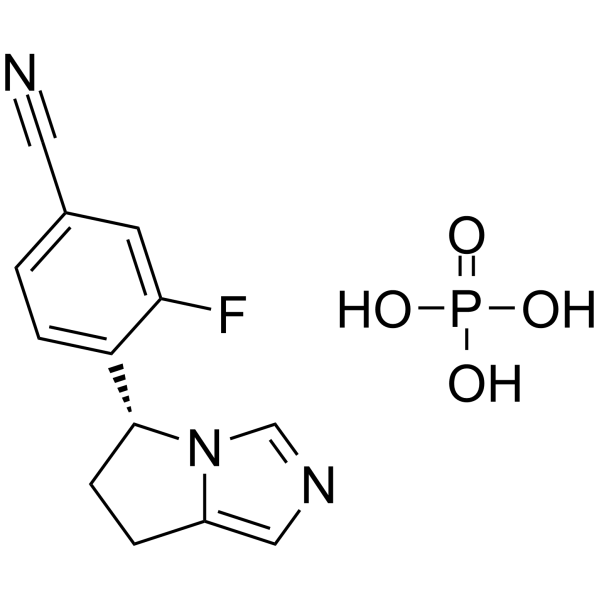1315449-72-9
| Name | osilodrostat phosphate |
|---|---|
| Synonyms |
Benzonitrile, 4-[(5R)-6,7-dihydro-5H-pyrrolo[1,2-c]imidazol-5-yl]-3-fluoro-, phosphate (1:1)
UNII-Y6581YAW9V osilodrostat phosphate LCI699-AZA 4-[(5R)-6,7-Dihydro-5H-pyrrolo[1,2-c]imidazol-5-yl]-3-fluorobenzonitrile phosphate (1:1) 4-[(5R)-6,7-dihydro-5H-pyrrolo[1,2-c]imidazol-5-yl]-3-fluorobenzonitrile dihydrogen phosphate |
| Description | Osilodrostat (LCI699) phosphate is a potent, orally active11β-hydroxylase (CYP11B1) inhibitor with an IC50 value of 35 nM. Osilodrostat phosphate is a potent, orally aldosterone synthase (CYP11B2) inhibitor with IC50 values of 0.7 nM and 160 nM for human aldosterone synthase and rat aldosterone synthase, respectively. Osilodrostat phosphate inhibits aldosterone and corticosterone synthesis. Osilodrostat phosphate has blood pressure lowering ability. Osilodrostat phosphate can be used for research of Cushing syndrome (CS)[1][2][3]. |
|---|---|
| Related Catalog | |
| Target |
IC50: 35 nM (CYP11B1), 0.7 nM (human aldosterone synthase), and 160 nM (rat aldosterone synthase)[1][2] |
| In Vitro | Osilodrostat (LCI699; 0.01-10 µM; HAC15 cells, 17 primary human adrenocortical cell cultures, and pituitary adenoma cells) phosphate inhibits cortisol and aldosterone. Osilodrostat results in inhibition of corticosterone, 11-deoxycortisol accumulation, and modest effects on adrenal androgens[2]. |
| In Vivo | Osilodrostat (LCI699; 0.1-100 mg/kg; p.o.; once) phosphate inhibits aldosterone and corticosterone synthesis in Ang-II- and ACTH-stimulated Sprague Dawley rats[1]. Osilodrostat (LCI699; 3-100 mg/kg; p.o.; daily, for 52 weeks) phosphate reduces mean arterial pressure and prolongs survival in dTG rats[1]. Animal Model: Male Ang-II- and ACTH-stimulated Sprague Dawley rats[1] Dosage: 0.1, 0.3, 1 and 3 mg/kg (Ang-II-stimulated rats) and 1, 3, 10, 30 and 100 mg/kg (ACTH-stimulated rats) Administration: Oral administration; once Result: Inhibited the increase in plasma aldosterone concentrations stimulated by Ang II or ACTH in a dose-dependent manner. Animal Model: dTG rats[1] Dosage: 3, 10, 30 and 100 mg/kg Administration: Oral administration; daily, for 52 weeks Result: Increased fractional LV (systolic and diastolic) shortening, normalized LV isovolumic relaxation time to RR (IVRT/RR) ratio and myocardial cell size and reduced LV weight in a dose-dependent manner. |
| References |
| Molecular Formula | C13H13FN3O4P |
|---|---|
| Molecular Weight | 325.232 |
| Exact Mass | 325.062775 |
